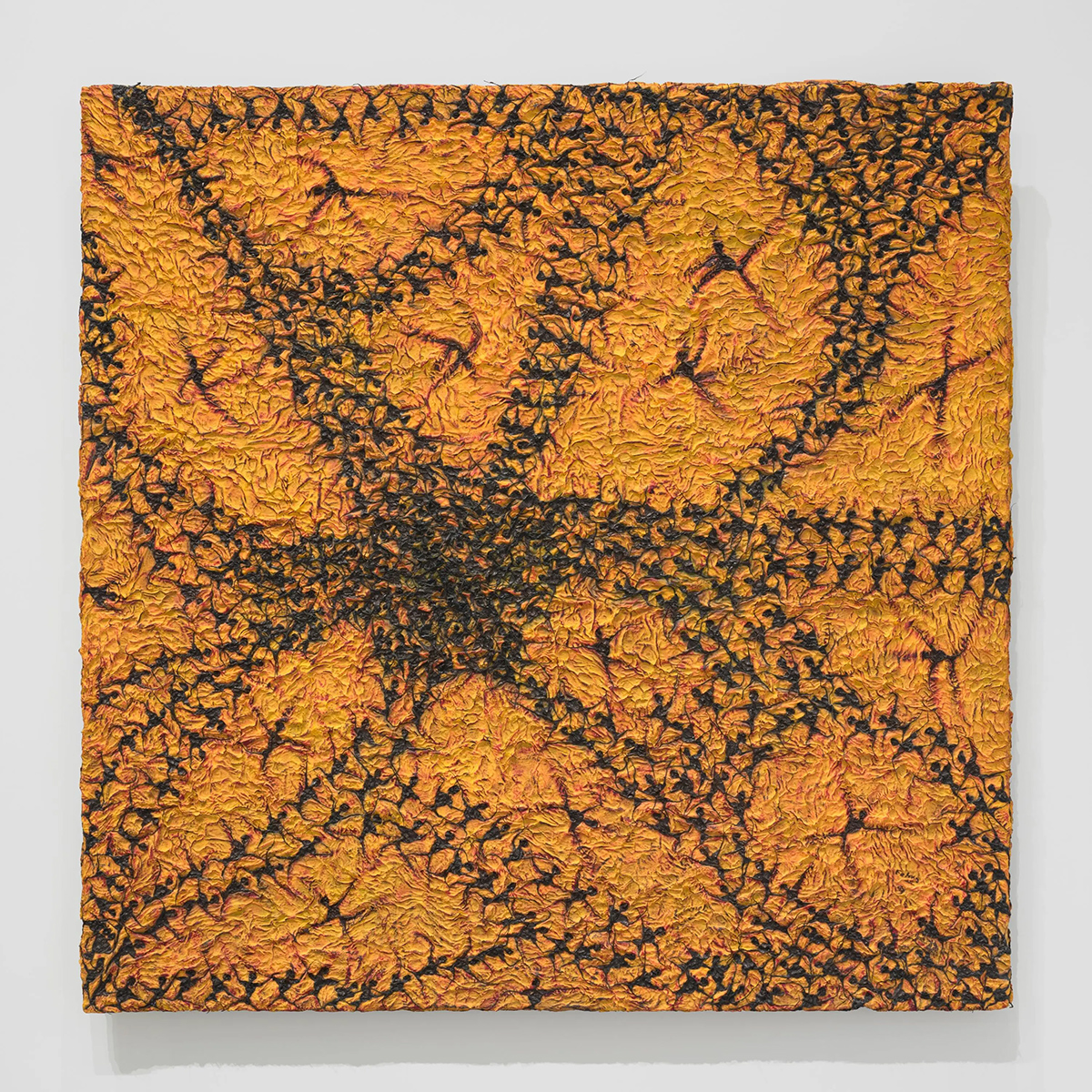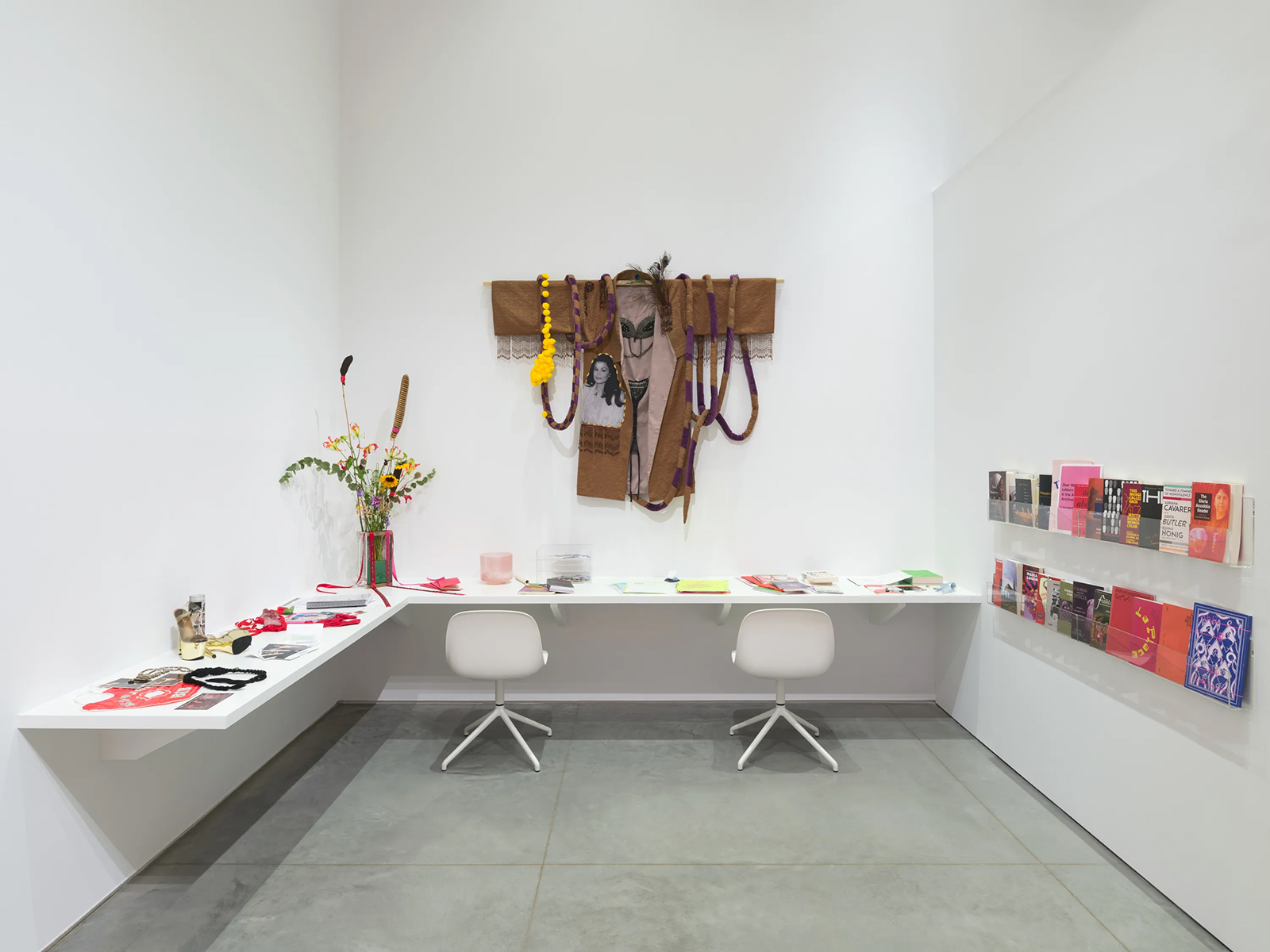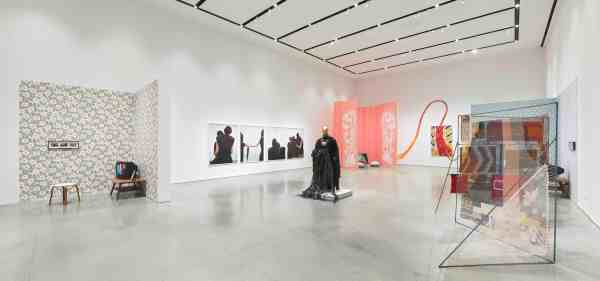Cantando Bajito: Chorus

Curated by Roxana Fabius, Beya Othmani, Mindy Seu, and Susana Vargas Cervantes
Translated into English as “singing softly,” the exhibition series title is drawn from a phrase used by Dora María Téllez Argüello, a now-liberated Nicaraguan political prisoner, to describe the singing exercises she did while she was incarcerated in isolation. Helping her to conserve her voice and defeat the political terror she endured, Téllez’s quiet singing became a powerful strategy for survival and resistance. Conceived in three movements, Cantando Bajito features artists who explore similar forms of creative resistance in the wake of widespread gender-based violence.
Cantando Bajito: Chorus, the third and final movement in the exhibition series is an invitation to reflect on the importance of collective making, organizing, and care arising from interdependence in shared struggles. The works illuminate how the coming together of bodies forges power out of precarity. Chorus evokes a twofold meaning: a choral body—an assembly of disparate voices that build together—and the refrain of a song, which carries both a repeating central idea, and a ‘hook’ that draws others in to add their voice. Chorus invites all to enter into a collective performance. This performance aims to reflect what sociologist Leticia Sabsay has called the ‘aesthetics of vulnerability.’ This concept shows the liberating potential of bodies that face vulnerability en masse, rallying against the all-too-present aesthetics of cruelty that seeks to divide people along gendered, sexualized, racialized, and national lines. Chorus is a call to join in a multivocal refrain of resistance transcending dividing lines. Artworks in Chorus reflect how vulnerability can act as an effective mobilizing force, and the exhibition recognizes the agency of those facing and countering systemic violence together.
With special thanks to members of the Cantando Bajito curatorial advisory group: Isis Awad, María Carri, Zasha Colah, Maria Catarina Duncan, Kobe Ko, Marie Hélène Pereira.
Image courtesy of Archivo de la Memoria Trans Argentina (Trans Memory Archive Argentina).
About the Curators
Roxana Fabius
Roxana Fabius is a Uruguayan curator and art administrator based in New York City. Between 2016 and 2022 she was Executive Director at A.I.R. Gallery, the first artist-run feminist cooperative space in the U.S. During her tenure at A.I.R. she organized programs and exhibitions with artists and thinkers such as Gordon Hall, Elizabeth Povinelli, Jack Halberstam, Che Gosset, Regina José Galindo, Lex Brown, Kazuko, Zarina, Mindy Seu, Naama Tzabar, and Howardena Pindell among many others. These exhibitions, programs and special commissions were made in collaboration with international institutions such as the Whitney Museum, Google Arts and Culture, The Feminist Institute, and Frieze Art Fair in New York and London. Fabius has served as an adjunct professor for the Curatorial Practices seminar at the Center for Curatorial Studies, Bard College, and Tel Aviv University. She has also taught at Parsons at The New School, City University of New York, Syracuse University, and Rutgers University. She is currently curating the 2024 exhibition series Cantando Bajito at the Ford Foundation Gallery.
Beya Othmani
Beya Othmani is an art curator and researcher from Algeria and Tunisia, dividing her time between Tunis and New York. Currently, she is the C-MAP Africa Fellow at the Museum of Modern Art (MoMA), New York. Her recent curatorial projects include the three-part exhibition series Cantando Bajito at the Ford Foundation Gallery, the Ljubljana 35th Graphic Arts Biennial, and Publishing Practices #2 at Archive Berlin. Previously, she took part in the curatorial teams of various projects with sonsbeek20→24 (2020), the Forum Expanded of the Berlinale (2019), and the Dak’Art 13 Biennial (2018), among others, and was a curatorial assistant at the Berlin-based art space SAVVY Contemporary. Some of her latest curatorial projects explored radical feminist publishing practices, post-colonial histories of print-making, and the construction of racial identities in art in colonial and post-colonial Africa.
Mindy Seu
Mindy Seu is a designer and technologist based in New York City and Los Angeles. Her expanded practice involves archival projects, techno-critical writing, performative lectures, and design commissions. Her latest writing surveys feminist economies, historical precursors of the metaverse, and the materiality of the internet. Mindy’s ongoing Cyberfeminism Index, which gathers three decades of online activism and net art, was commissioned by Rhizome, presented at the New Museum, and awarded the Graham Foundation Grant. She has lectured internationally at cultural institutions (Barbican Centre, New Museum), academic institutions (Columbia University, Central Saint Martins), and mainstream platforms (Pornhub, SSENSE, Google), and been a resident at MacDowell, Sitterwerk Foundation, Pioneer Works, and Internet Archive. Her design commissions and consultation include projects for the Serpentine Gallery, Canadian Centre for Architecture, and MIT Media Lab. Her work has been featured in Frieze, Vanity Fair, Dazed, Gagosian Quarterly, Brooklyn Rail, i-D, and more. She is currently an Associate Professor at University of California, Los Angeles in the Department of Design Media Arts.
Susana Vargas Cervantes
Susana Vargas Cervantes teaches, writes, and curates. Vargas Cervantes is a transdisciplinary scholar, internationally recognized for her artistic and academic work at the intersections of alternative criminology, visual studies, and queer studies—in both Anglo North America and Latin America. Her research mines the connections between gender, sexuality, class, and skin tonalities to reconceptualize pigmentocracy as a system of perception. She is the author of the book The Little Old Lady Killer: The Sensationalized Crimes of Mexico’s First Female Serial Killer (NYU Press, 2019) and Mujercitos (Editorial RM, 2015). After a Fulbright Visiting Fellowship at Columbia University, she joined Carleton University as an Assistant Professor in Communication and Media Studies.
Hoda Afshar
Archivo de la Memoria Trans Argentina (Trans Memory Archive Argentina)
Archivo Memoria Trans México/Hospital de ropa (Trans Memory Archive Mexico/Clothing Hospital)
Chloë Bass
Tania Candiani
Fatma Charfi
Lizania Cruz
Cyberfeminism Index
FAQ?
Cecilia Granara
Los Angeles Contemporary Archive
Mai Ling
Textiles Semillas (Textiles as Seeds)
The full exhibition guide of Cantando Bajito: Chorus is available on Bloomberg Connects. Explore the platform for a closer look at the works in the show, curatorial texts, accessible audio guides, and more.
Exhibition installation information
















Archivo de la Memoria Trans Argentina
(Argentina, founded 2012)
Constelaciones: Entre estrellas y cenizas (Constellations: Between stars and ashes), 2024
Archival photographs, piano, and frames
Dimensions variable
Courtesy of the Artists
Photo Sebastian Bach

Tania Candiani
(México City, b. 1973, lives and works in México City)
Manifestantes (Protesters), 2022-2024
Cotton canvases embroidered with cotton thread, high-density acrylic paint, and acrylic sealer
118 x 55 x 1 ¾ inches each
Courtesy of the Artist and Galeria Vermelho
Photo Sebastian Bach
Kabul, Afghanistan. 4 septiembre de 2021. Marcha femenina en favor de los derechos y la inclusión de las mujeres (Kabul, Afghanistan. September 4, 2021. Women’s march in favor of women’s rights and inclusion)
Based on the photography of Reuters / Stringer
Mendoza, Argentina. Marzo 8, 2017, M8 (Mendoza, Argentina, March 8, 2017, March for International Women’s Day)
Based on the photography of WordPress
Ciudad de México, México. Noviembre 25, 2019. Marcha por el día internacional de la eliminación de la violencia contra las mujeres (Mexico City, Mexico. November 25, 2019. March for the International Day for the Elimination of Violence against Women)
Based on the photography of Andrea Murcia, Cuartoscuro


Chloë Bass
(United States, b. 1984, lives and works in Brooklyn)
Cutting Room Floor #2 (Fethke Family), 2024
Cutting Room Floor #3 (Kumanomido Family), 2024
Cutting Room Floor #1 (Carroll Family), 2024
Digital video (color, sound); photographic stills on paper; text-based art on paper; installation elements (monitors, furniture, wallpaper)
Dimensions variable
Courtesy of the Artist and Alexander Gray Associates
Photo Sebastian Bach

Fatma Charfi
(1955-2018, lived and worked in Tunisia and Switzerland)
Mutation I, 1992
Cotton wadding, silk paper, glue, ink
60 x 60 inches
Courtesy of Nabil Mseddi
Photo Sebastian Bach

Hoda Afshar
(Iran, b. 1983, lives and works in Melbourne)
In Turn, 2023
Archival pigment prints
66 x 53 inches each
Courtesy of the Artist and Milani Gallery, Brisbane, Australia
Photo Sebastian Bach

Mai Ling
(Austria, founded 2019)
Becoming Stickiness, 2023/2024
Mixed-media two-channel video installation
Dimensions variable
Courtesy of the Artist
Photo Sebastian Bach

Cecilia Granara
(Jeddah, Saudi Arabia, b. 1991, lives and works in Paris, France and México City, México)
Occhi, Luce, Sangue, Stelle (Eyes, Light, Blood, Stars), 2023
Acrylic, airbrush, oil on canvas
71 x 43 x 1 ½ inches
Courtesy of the Artist and Cassina Projects
Photo Sebastian Bach

Textiles Semillas (Textiles as Seeds)
(Argentina, founded 2023)
El tejido mensaje-aliento-pensamiento-resistencia (The weaving message-breath-thought-resistance), 2024
Iron, llama fiber, sheep wool, chaguar fiber, cotton, industrial yarns, artisanal dyes using leaves, roots, bark, vegetable peels, anilines
Dimensions variable
Courtesy of the Textiles Semillas Collection
Photo Sebastian Bach

Archivo Memoria Trans México/Hospital de ropa (Trans Memory Archive Mexico/Clothing Hospital)
(Mexico, founded 2022)
Emma Yesica Duvali and Erick Molina
Gabriela Martell (Durango, c. 1959–Mexico City, November 20, 2001), 2022
Textile, kimono, and mixed media
Dimensions variable
Courtesy of Archivo Memoria Trans México
Photo Sebastian Bach

Archivo Memoria Trans México/Hospital de ropa (Trans Memory Archive Mexico/Clothing Hospital)
(Mexico, founded 2022)
Terry Holiday and María Ponce
Scream Dress—Superperra (Oswaldo Calderón, Mexico City, 1973–February 14, 2020), 2022
Textile and mixed media
Dimensions variable
Courtesy of Archivo Memoria Trans México
Photo Sebastian Bach

Collective Desk
Collective Desk, 2024
Various objects, books, and photos
Dimensions variable
Courtesy of the curators of Cantando Bajito
Photo Sebastian Bach
PDF of Further Reading List

Los Angeles Contemporary Archive
(United States, founded 2021)
Private Practices: AAPI Artist and Sex Worker Collection, 2021-
Mixed media
Dimensions variable
Courtesy of Private Practices Collection, Los Angeles Contemporary Archive (LACA)
Photo Sebastian Bach

Lizania Cruz
(Dominican Republic, b. 1983, lives and works in New York City)
To Feel, To Resist, and To Flourish, 2024
Flowers
Dimensions variable
Courtesy of the Artist
Photo Sebastian Bach
PDF of To Feel, To Resist, and To Flourish pamphlet

FAQ?
(Japan, founded 2021)
Exchange Journal, 2024
Mixed media
11 ¾ x 11 ¾ x 1 ½ inches
Courtesy of FAQ?
Photo Sebastian Bach

Cyberfeminism Index
(United States, founded 2018)
Cyberfeminism Index book, 3D-printed speculum, gender changers hardware, QR code ring, USB drive, books, zines
Dimensions variable
Courtesy of Mindy Seu
Photo Sebastian Bach




